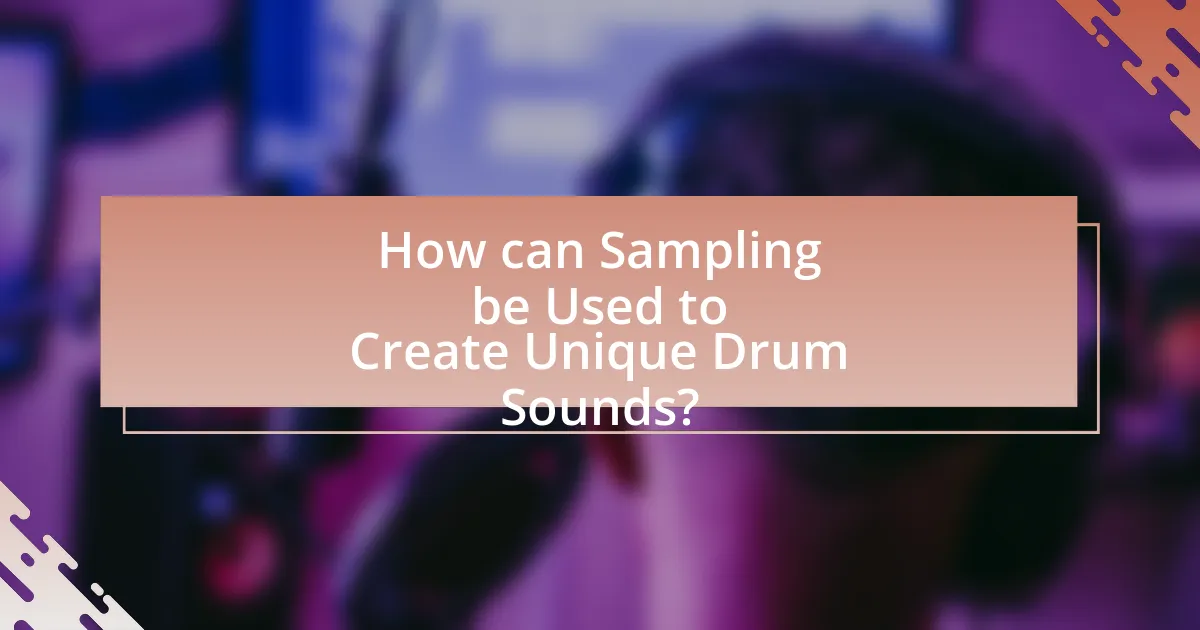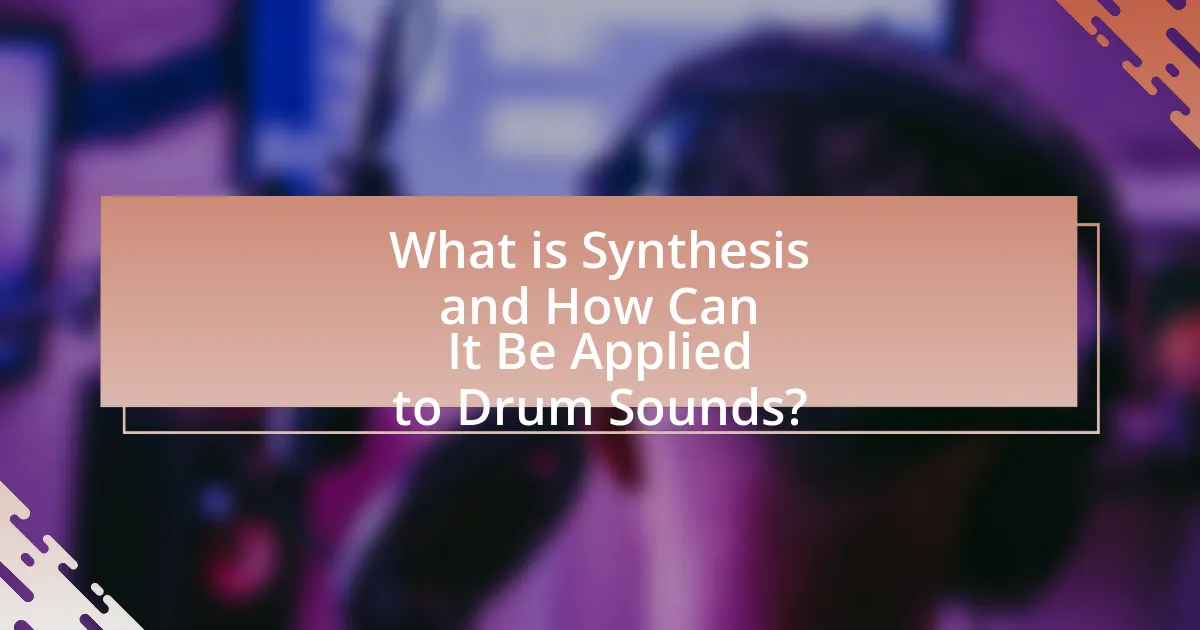The article focuses on the significance of unique drum sounds for indie bands, emphasizing their role in establishing a band’s identity and enhancing audience engagement. It explores how distinctive percussive tones, achieved through unconventional drum kits, sampling, and synthesis techniques, contribute to a band’s signature sound. Key elements such as timbre, dynamics, and production methods are discussed, along with best practices for sound design, including layering samples and utilizing effects. The article also highlights the impact of drum tuning and maintenance on sound quality, providing practical tips for indie bands to effectively experiment with their drum sounds.

What are Unique Drum Sounds and Why are They Important for Indie Bands?
Unique drum sounds are distinctive percussive tones that set a band’s music apart, contributing to its identity and style. These sounds are crucial for indie bands as they help create a signature sound that resonates with audiences, differentiating them in a crowded music landscape. For instance, the use of unconventional drum kits or electronic manipulation can evoke specific emotions and enhance the overall aesthetic of a track. Research indicates that unique sound design can significantly impact listener engagement and retention, making it a vital aspect of modern music production for indie artists.
How can unique drum sounds enhance the overall sound of an indie band?
Unique drum sounds can significantly enhance the overall sound of an indie band by providing distinct rhythmic textures that differentiate their music from mainstream genres. These unique sounds can create a signature style, allowing the band to establish a recognizable identity. For instance, the use of unconventional percussion instruments or innovative sampling techniques can introduce fresh sonic elements that captivate listeners. Research indicates that bands like Alt-J and Bon Iver have successfully utilized unique drum sounds to create atmospheric layers in their music, contributing to their critical acclaim and commercial success. This approach not only enriches the auditory experience but also fosters emotional connections with the audience, making the music more memorable.
What role do drum sounds play in defining a band’s identity?
Drum sounds play a crucial role in defining a band’s identity by establishing their rhythmic foundation and influencing their overall sound. The specific timbres, patterns, and production techniques used in drum sounds can evoke particular emotions and styles, helping to differentiate one band from another. For instance, bands like The White Stripes utilize raw, unprocessed drum sounds to create a garage rock aesthetic, while electronic bands may employ synthesized beats to craft a more polished, modern sound. This distinctiveness is supported by the fact that iconic drummers often become synonymous with their bands, as seen with John Bonham of Led Zeppelin, whose powerful drumming style is integral to the band’s identity. Thus, the choice of drum sounds is not merely a technical decision but a fundamental aspect of a band’s artistic expression and recognition in the music industry.
How do unique drum sounds contribute to audience engagement?
Unique drum sounds enhance audience engagement by creating a distinctive auditory experience that captures attention and evokes emotional responses. When bands utilize innovative drum sounds, they differentiate themselves from others, making their music more memorable. Research indicates that unique soundscapes can stimulate listener interest and increase retention, as evidenced by a study published in the Journal of Experimental Psychology, which found that novel auditory stimuli significantly enhance emotional engagement and memory recall in listeners. This connection between unique drum sounds and audience engagement underscores the importance of creativity in music production for indie bands.
What are the key elements that make up unique drum sounds?
Unique drum sounds are primarily defined by their timbre, pitch, dynamics, and the techniques used in their production. Timbre refers to the distinct tonal quality of the drum, influenced by the materials used (such as wood or metal) and the drum’s construction. Pitch is determined by the size and tension of the drumhead, affecting how high or low the sound is. Dynamics involve the volume and intensity of the sound, which can be manipulated through playing techniques or electronic processing. Additionally, production techniques such as layering samples, applying effects like reverb or distortion, and utilizing unique recording methods contribute to the distinctiveness of drum sounds. These elements collectively enable musicians to create innovative and personalized drum sounds that stand out in their music.
How do different drum kits and percussion instruments affect sound uniqueness?
Different drum kits and percussion instruments significantly affect sound uniqueness by varying their materials, construction, and design, which influence tonal characteristics and resonance. For instance, a wooden drum kit typically produces a warmer, richer sound due to the natural properties of wood, while metal drums generate a brighter, sharper tone. Additionally, the size and shape of the drums, such as a deeper bass drum providing a fuller sound compared to a shallower one, further contribute to the overall sonic profile. The choice of percussion instruments, like tambourines or shakers, adds distinct textures and rhythmic variations, enhancing the uniqueness of the sound. These factors collectively shape the auditory identity of a musical piece, making it recognizable and distinct.
What is the impact of drum tuning and maintenance on sound quality?
Drum tuning and maintenance significantly impact sound quality by ensuring optimal resonance and tonal clarity. Proper tuning allows drums to produce their intended pitch and sustain, which enhances the overall musicality of the instrument. For instance, a study by the Percussive Arts Society indicates that well-tuned drums can improve projection and articulation, making them more responsive to playing dynamics. Additionally, regular maintenance, such as replacing worn drumheads and checking hardware, prevents unwanted overtones and ensures consistent sound quality, ultimately contributing to a more polished performance.

How can Sampling be Used to Create Unique Drum Sounds?
Sampling can be used to create unique drum sounds by capturing and manipulating audio recordings of various percussive sources. This technique allows musicians to blend different textures and timbres, resulting in distinctive drum sounds that stand out in a mix. For instance, artists can sample everyday objects, such as pots or claps, and process them through effects like reverb or distortion to create innovative rhythms. Additionally, the use of software like Ableton Live or Logic Pro enables precise editing and layering of samples, further enhancing creativity. Historical examples include the use of sampling in hip-hop, where producers like J Dilla and DJ Premier transformed ordinary sounds into iconic beats, demonstrating the effectiveness of sampling in crafting unique drum sounds.
What is sampling and how does it work in music production?
Sampling is the process of taking a portion of a sound recording and reusing it in a different song or piece of music. In music production, sampling works by capturing audio snippets from existing recordings, which can then be manipulated, looped, or altered to create new compositions. This technique allows producers to incorporate diverse sounds and textures, enhancing the overall sonic palette of their music. Historically, sampling gained prominence in the late 20th century with the advent of hip-hop and electronic music, where artists like Grandmaster Flash and the Beastie Boys utilized it to innovate and redefine genres. The legality of sampling often requires obtaining permission or licensing from the original copyright holders, which underscores its significance in both creative and legal contexts.
What types of sounds can be sampled for drum creation?
Various types of sounds can be sampled for drum creation, including acoustic drum hits, electronic drum sounds, found sounds, and percussive elements from everyday objects. Acoustic drum hits consist of recordings from traditional drums like snare, kick, and toms, which provide a natural sound. Electronic drum sounds are synthesized or sampled from drum machines, offering a wide range of tonal possibilities. Found sounds, such as claps, snaps, or even environmental noises, can add unique textures to drum tracks. Additionally, percussive elements from objects like pots, pans, or shakers can be recorded and manipulated to create distinctive drum sounds. This diversity in sound sources allows for innovative and unique drum compositions in music production.
How do you choose the right samples for your band’s style?
To choose the right samples for your band’s style, first identify the genre and emotional tone of your music. This involves analyzing the characteristics of your band’s sound, such as tempo, instrumentation, and mood. For instance, if your band leans towards a lo-fi indie sound, selecting samples that have a warm, vintage quality can enhance that aesthetic. Additionally, consider the context of your songs; samples should complement the lyrical themes and overall vibe. Research shows that using samples that resonate with your band’s identity can lead to a more cohesive sound, as evidenced by successful indie bands who curate their samples to reflect their unique style.
What are the best practices for using samples in drum sound design?
The best practices for using samples in drum sound design include selecting high-quality samples, layering multiple samples for depth, and applying effects to enhance uniqueness. High-quality samples ensure clarity and fidelity, which are crucial for professional sound. Layering different samples, such as combining a kick drum with a clap, creates a fuller sound and adds complexity. Additionally, applying effects like EQ, compression, and reverb can shape the samples to fit the mix better, making them more distinctive. These practices are supported by industry standards, where producers often emphasize the importance of sound quality and creativity in drum programming.
How can layering samples enhance the richness of drum sounds?
Layering samples enhances the richness of drum sounds by combining multiple audio sources to create a fuller, more complex sonic texture. This technique allows producers to blend different drum hits, each with unique tonal qualities and dynamics, resulting in a sound that is more engaging and versatile. For instance, layering a punchy kick drum with a softer, more resonant kick can produce a sound that maintains impact while adding depth. Additionally, research in sound design indicates that layering can help mask undesirable frequencies and enhance the overall presence of the drum sounds in a mix, making them stand out more effectively in a musical context.
What tools and software are recommended for effective sampling?
For effective sampling, recommended tools and software include Ableton Live, Native Instruments Kontakt, and Logic Pro X. Ableton Live is widely used for its intuitive interface and powerful sampling capabilities, allowing users to manipulate audio easily. Native Instruments Kontakt is a versatile sampler that offers extensive libraries and sound design options, making it ideal for creating unique drum sounds. Logic Pro X provides a comprehensive suite of sampling tools, including the EXS24 sampler, which supports a wide range of audio formats and offers advanced editing features. These tools are favored in the music production community for their reliability and functionality in crafting distinctive sounds.

What is Synthesis and How Can It Be Applied to Drum Sounds?
Synthesis is the process of generating sound through electronic means, typically using oscillators, filters, and modulation techniques. In the context of drum sounds, synthesis can be applied to create unique and customizable percussion elements by manipulating waveforms, adjusting parameters like pitch and envelope, and layering different synthesized sounds to achieve desired textures. For example, subtractive synthesis can shape a basic waveform into a snare or kick drum by filtering out certain frequencies and adding resonance, while FM synthesis can produce complex timbres that mimic acoustic drums or create entirely new sounds. This approach allows musicians to design drum sounds that stand out in a mix, catering to the specific aesthetic of indie bands.
What are the basics of drum sound synthesis?
Drum sound synthesis involves creating drum sounds using electronic methods rather than traditional acoustic instruments. The basics include understanding waveforms, which are the building blocks of sound; common waveforms used in drum synthesis are sine, square, sawtooth, and noise. Additionally, drum sound synthesis often employs techniques such as subtractive synthesis, where harmonics are filtered out to shape the sound, and additive synthesis, where multiple waveforms are combined to create complex tones.
Furthermore, envelope generators control the dynamics of the sound, shaping parameters like attack, decay, sustain, and release (ADSR), which are crucial for mimicking the natural characteristics of drum hits. Finally, effects such as reverb, delay, and distortion can be applied to enhance the synthesized drum sounds, making them more unique and fitting for various musical styles.
How do different synthesis methods (subtractive, additive, etc.) affect drum sounds?
Different synthesis methods, such as subtractive and additive synthesis, significantly affect drum sounds by altering their tonal characteristics and texture. Subtractive synthesis shapes drum sounds by filtering harmonics from a rich waveform, resulting in a punchy and focused sound, often used for kick drums and snares. For example, a low-pass filter can remove higher frequencies, creating a deeper bass drum sound. In contrast, additive synthesis builds drum sounds by layering sine waves at various frequencies, allowing for complex and rich textures, which can produce unique cymbals or percussive elements. This method enables precise control over each harmonic, leading to distinctive timbres. The choice of synthesis method directly influences the overall sonic quality and versatility of drum sounds in music production.
What are the essential parameters to manipulate in drum synthesis?
The essential parameters to manipulate in drum synthesis include pitch, envelope, filter, and modulation. Pitch determines the fundamental frequency of the drum sound, affecting its perceived tone. The envelope, typically defined by attack, decay, sustain, and release (ADSR), shapes the sound’s dynamic characteristics over time. Filters, such as low-pass or high-pass, modify the frequency content, allowing for tonal shaping and resonance adjustments. Modulation parameters, including LFO (low-frequency oscillator) settings, introduce movement and variation, enhancing the sound’s complexity. These parameters are crucial for creating distinctive and tailored drum sounds in synthesis.
How can synthesis techniques be combined with sampling for unique results?
Synthesis techniques can be combined with sampling to create unique results by layering synthesized sounds over sampled drum hits, allowing for the manipulation of timbre and texture. This approach enables musicians to blend the organic qualities of sampled sounds with the versatility of synthesized elements, resulting in innovative drum patterns. For instance, using a synthesizer to generate bass frequencies can enhance the depth of a sampled kick drum, while applying modulation effects to a sampled snare can introduce dynamic variations. This method has been effectively utilized in genres like electronic and indie music, where artists often seek distinctive sonic identities.
What are the advantages of blending sampled and synthesized drum sounds?
Blending sampled and synthesized drum sounds offers the advantage of combining the authenticity of real drum sounds with the versatility of synthesized tones. This hybrid approach allows musicians to create unique textures and dynamics that are not achievable with either method alone. For instance, sampled drums provide realistic acoustic characteristics, while synthesized sounds can introduce innovative effects and tonal variations. The integration of both can enhance the overall sonic palette, enabling indie bands to craft distinctive rhythms that stand out in their music.
How can effects processing enhance synthesized drum sounds?
Effects processing can significantly enhance synthesized drum sounds by adding depth, texture, and character. Techniques such as reverb can create a sense of space, making the drums feel more immersive, while compression can tighten the sound and increase punchiness, resulting in a more impactful rhythm. Additionally, modulation effects like chorus or flanger can introduce movement and richness, transforming static sounds into dynamic elements. Studies have shown that the use of effects can lead to a more engaging listening experience, as they allow for greater sonic variety and creativity in music production.
What are some practical tips for crafting unique drum sounds?
To craft unique drum sounds, experiment with layering different samples and using unconventional sound sources. Layering allows you to combine various textures, such as blending acoustic drum hits with electronic sounds, which can create a richer and more distinctive sound. Additionally, utilizing unconventional sources like household items or field recordings can introduce unique timbres that are not typically found in standard drum kits. For instance, using a metal trash can lid as a snare or recording claps from a group of people can yield fresh and innovative results.
How can indie bands experiment with their drum sounds effectively?
Indie bands can effectively experiment with their drum sounds by utilizing a combination of sampling, layering, and electronic manipulation techniques. By sampling various acoustic and electronic drum sounds, bands can create unique textures that differentiate their music. Layering different drum samples allows for richer soundscapes, while electronic manipulation, such as pitch shifting and time stretching, can further enhance the originality of the drum tracks. Research indicates that innovative sound design, including the use of unconventional percussion instruments and effects, can lead to distinctive rhythmic patterns that resonate with listeners, as seen in the works of bands like Bon Iver and Radiohead.
What common mistakes should be avoided when creating unique drum sounds?
Common mistakes to avoid when creating unique drum sounds include relying too heavily on stock samples, neglecting sound layering, and ignoring the importance of tuning. Overusing stock samples can lead to a lack of originality, as many producers may use the same sounds. Sound layering enhances complexity and depth; failing to layer can result in flat and uninspiring drum sounds. Additionally, tuning drum sounds to fit the key of the track can significantly improve their integration; neglecting this aspect can create dissonance and reduce the overall quality of the mix.


